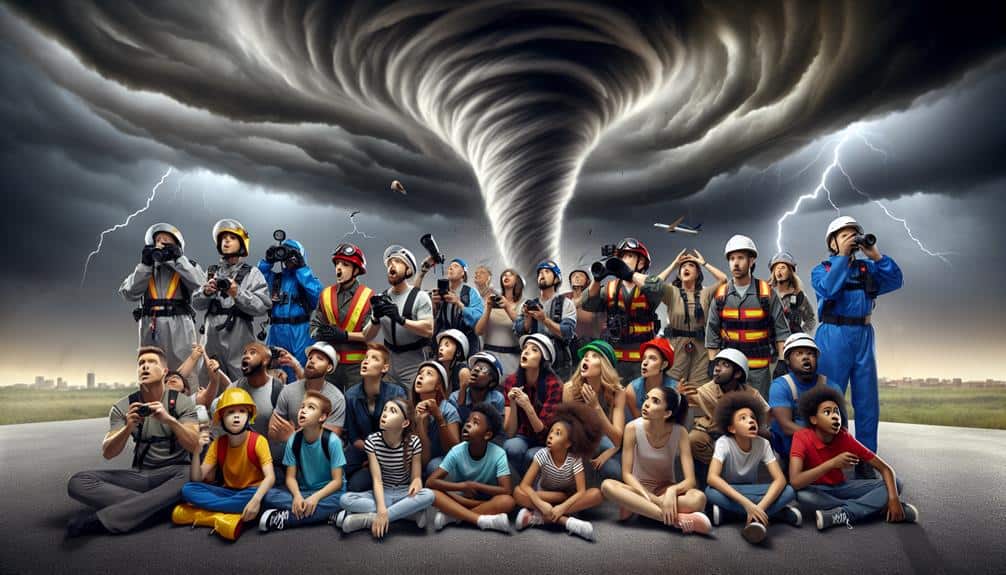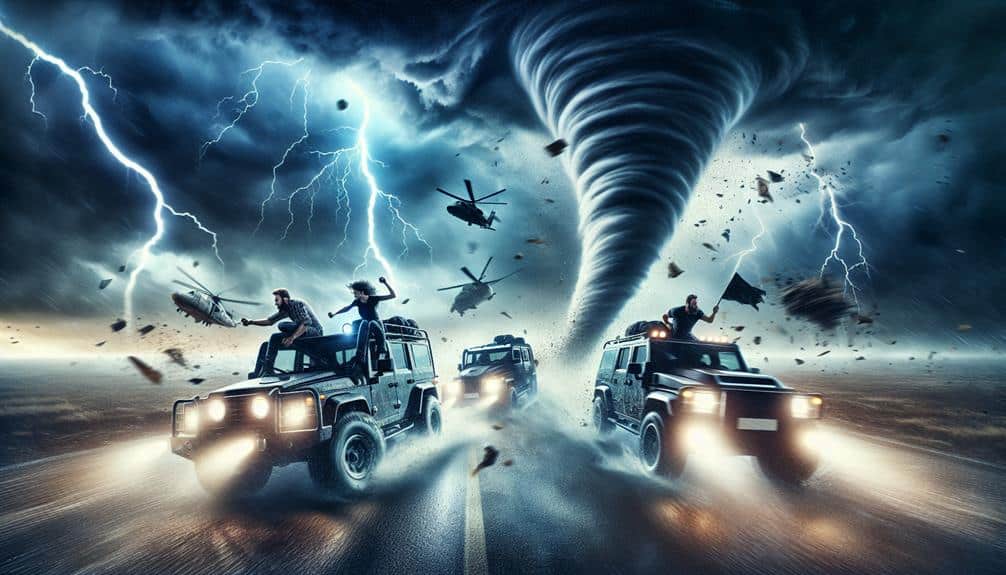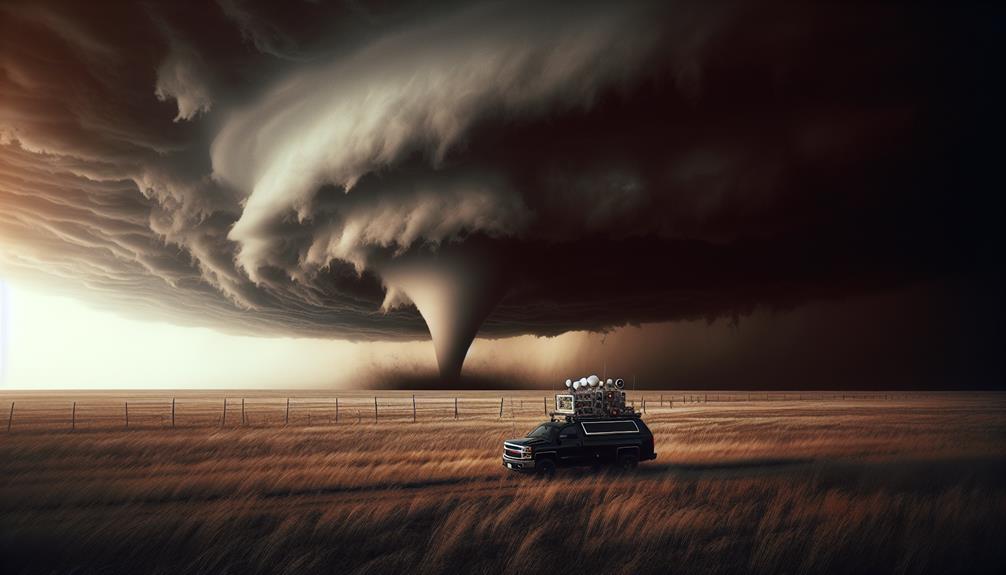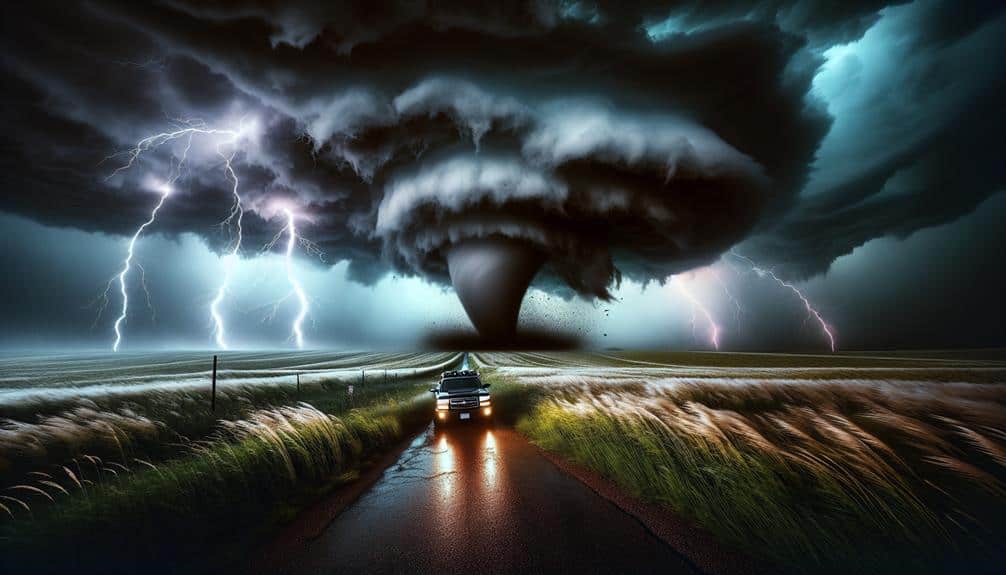Storm chasing safety guidelines are essential because they protect our lives and equipment, reduce legal risks, enhance data collection, improve team coordination, and educate the public. By following established protocols and utilizing advanced technologies such as radar and GPS, we maintain situational awareness and operational efficiency. Legal adherence and comprehensive risk management prevent liabilities. Standardized data collection methods guarantee scientific accuracy. Clear communication and specified roles streamline teamwork. Lastly, public education on safety promotes community preparedness and resilience. Understanding these guidelines helps us fully grasp their significance.
Key Points
- Ensures the protection and well-being of storm chasers through adherence to established safety protocols.
- Minimizes legal risks by demonstrating responsible storm chasing practices with necessary permits and insurance.
- Enhances data collection accuracy and reliability through standardized measurement protocols and advanced technology.
- Promotes effective team coordination and clear communication, ensuring swift and safe actions during missions.
Protecting Lives and Equipment
Securing the safety of both lives and equipment during storm chasing demands strict adherence to established protocols and the use of specialized technology. We must prioritize risk prevention and gear protection to maintain operational efficiency and safeguard our well-being. Utilizing real-time data from radar systems, GPS tracking, and meteorological sensors enhances our situational awareness and allows for informed decision-making.
Effective safety training is vital for our team. Thorough drills on emergency response scenarios enable us to react promptly and appropriately to unpredictable weather conditions. This training also includes mastering the use of personal protective equipment (PPE) such as helmets, reinforced boots, and weather-resistant clothing.
Our vehicles are equipped with reinforced exteriors and advanced communication systems to guarantee continuous contact with each other and emergency services. Regular maintenance checks on all gear, including cameras and storm detection instruments, are essential to prevent malfunctions that could jeopardize our missions.
Minimizing Legal Risks
How can we effectively minimize legal risks while storm chasing to guarantee compliance with regulations and protect our team?
First, we must understand the significance of legal liability and risk management. By adhering to established safety guidelines, we ascertain that our actions are within the framework of local, state, and federal laws. This helps in preventing any legal repercussions that could arise from property damage or personal injury.
We need to prioritize obtaining the necessary permits and insurance. This not only safeguards us but also demonstrates our commitment to responsible storm chasing. Additionally, having a thorough risk management plan in place is vital. This plan should include clearly defined roles, communication protocols, and emergency response procedures. It's essential that all team members are trained on these protocols to guarantee quick and effective action when needed.
Furthermore, documenting our activities meticulously can serve as evidence that we've followed all safety and legal guidelines. This documentation can be invaluable in defending against potential lawsuits.
Enhancing Data Collection
While maintaining compliance with legal standards, we must also focus on improving data collection to maximize the scientific value of our storm chasing missions. By adopting advanced meteorological instruments and deploying them strategically, we can greatly enhance forecasting models. High-resolution Doppler radar, anemometers, and barometers are essential in capturing dynamic atmospheric data with precision.
To guarantee the accuracy of our collected data, standardizing our measurement protocols is crucial. This includes calibrating instruments before deployment and aligning our data collection efforts with established scientific methodologies. Additionally, the integration of GPS-enabled devices allows us to geo-tag data points, adding spatial context that's vital for accurate storm analysis.
Real-time data transmission technologies enable immediate analysis and decision-making, which not only improves the quality of our research but also promotes safety. Drones equipped with specialized sensors can access areas that are otherwise risky for human observers, thereby expanding our data collection capabilities.
As we continue to refine our techniques, the focus remains on ensuring that each data point contributes to a robust and reliable forecasting model. By meticulously collecting and analyzing storm data, we can make significant advancements in meteorological science while preserving the freedom to explore and understand nature's most powerful phenomena.
Promoting Team Coordination
Effective team coordination is crucial for the success and safety of our storm chasing missions, requiring clear communication protocols and well-defined roles. We rely on precise team dynamics to make certain that each member understands their responsibilities and can act swiftly under pressure. Without structured communication strategies, the risk of miscommunication escalates, potentially leading to hazardous situations.
Our team utilizes real-time data sharing through reliable communication channels, like two-way radios and mobile data networks. This allows us to distribute meteorological data and updates instantly, guaranteeing everyone is on the same page. We also conduct pre-chase briefings and post-chase debriefings to continuously enhance our strategies.
Defined roles within the team, such as driver, navigator, meteorologist, and safety officer, streamline decision-making processes. Each role comes with specific tasks, reducing overlap and confusion during critical moments. For example, the navigator uses GPS and weather maps to guide the driver, while the meteorologist interprets data to predict storm paths.
Educating the Public

Educating the public about storm chasing and severe weather safety is crucial to minimize risks and enhance community preparedness. By increasing public awareness, we can equip our communities with the knowledge they need to make informed decisions during severe weather events.
Safety education should cover the basics of meteorological phenomena, risk assessment, and appropriate responses to various storm scenarios.
We must leverage data-driven approaches to illustrate the significance of safety measures. For instance, statistics show that individuals who are well-informed about tornadoes and severe thunderstorms are less likely to take unnecessary risks. When the public comprehends the technical terminology and meteorological data, they can better interpret storm warnings and advisories.
Public awareness campaigns should utilize various platforms, including social media, local news, and community workshops. These programs can provide practical advice on creating emergency kits, developing family communication plans, and recognizing the signs of impending severe weather.
By making safety education accessible and engaging, we empower individuals to take responsibility for their own safety without feeling restricted.
Ultimately, a well-educated public is more resilient and capable of facing the challenges posed by severe weather. Let's make certain that our communities are prepared, informed, and ready to act when it matters most.
Frequently Asked Questions
What Qualifications Are Needed to Become a Certified Storm Chaser?
To become certified storm chasers, we need to meet specific training requirements, including meteorology courses and severe weather workshops. Additionally, acquiring substantial field experience under veteran chasers' guidance is essential to guarantee scientific accuracy and operational safety.
How Do Storm Chasers Communicate With Local Emergency Services?
Did you know 70% of storm chasers use real-time emergency communication tools? We guarantee safety protocols by constantly updating local emergency services about severe weather conditions, using radio frequencies, satellite phones, and specialized apps for accurate, timely information.
What Are the Common Types of Storms That Storm Chasers Monitor?
We focus on hurricane tracking and tornado forecasting. These storms' dynamics include wind patterns, atmospheric pressure changes, and thermal gradients. Our aim is to gather precise data, enhancing predictive models and enabling timely, life-saving alerts.
How Do Storm Chasers Fund Their Expeditions?
How do we fund our expeditions? Through various funding sources like sponsors and grants. Financial challenges arise, but we employ budgeting strategies to manage costs effectively, ensuring our passion for storm chasing remains unstoppable, like a force of nature.
What Tools and Technology Do Storm Chasers Use to Predict Storm Paths?
We rely on satellite imagery and radar technology to predict storm paths. These tools provide real-time data, allowing us to analyze atmospheric conditions and track storm developments, ensuring we stay ahead and maintain our freedom to chase safely.


